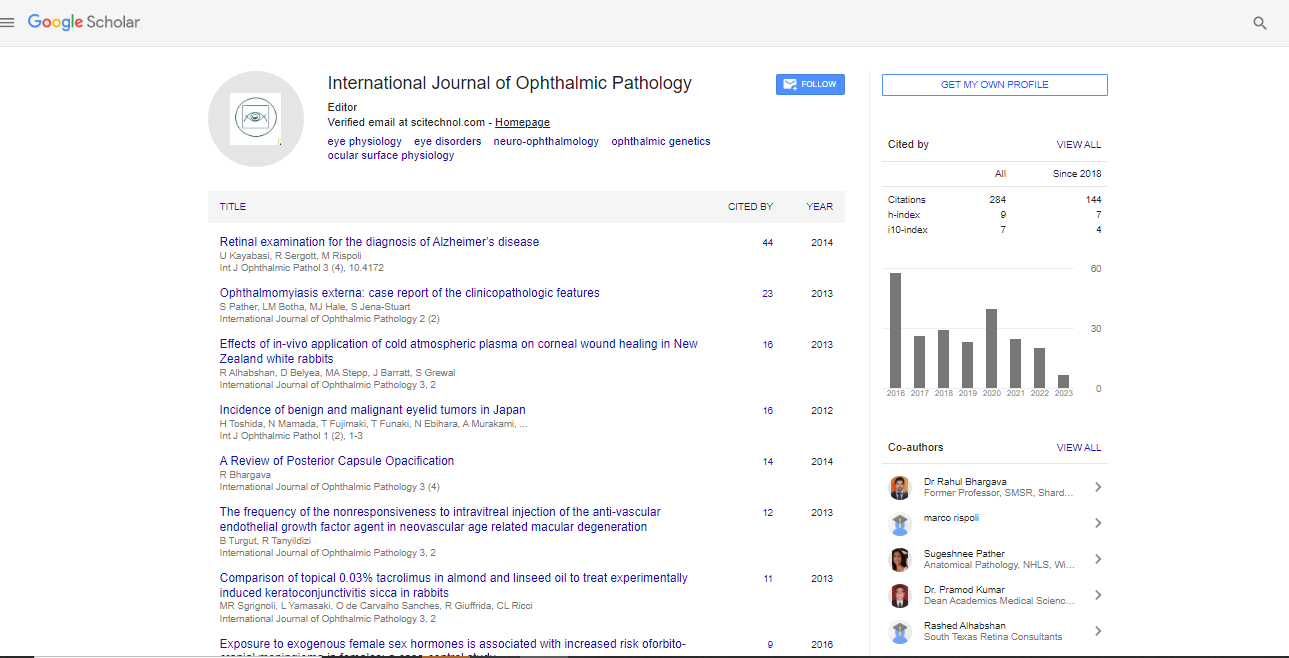Short Communication, Int J Ophthalmic Pathol Vol: 0 Issue: 0
Strategies to Direct Eye Conditions to Avoid Vision Impairment
Sathvika Mandala*
Department of Biotechnology, Avanthi Institute of Pharmaceuticals, Hyderabad, India.
*Corresponding Author:
Sathvika Mandala
Department of Biotechnology, Avanthi Institute of Pharmaceuticals, Hyderabad, India.
E-mail: sathvika21@gmail.com
Received: July 05, 2021 Accepted: July 19, 2021 Published: July 26, 2021
Citation: Mandala S (2021) Strategies to Direct Eye Conditions to Avoid Vision Impairment. Int J Ophthalmic Pathol 10:7. (291)
Abstract
A person’s experience of vision impairment varies depending upon many different factors. This includes for example, the availability of prevention and treatment interventions, access to vision rehabilitation (including assistive products such as glasses or white canes), and whether the person experiences problems with inaccessible buildings, transport and information.
Keywords: Eye Conditions , Vision Impairment
Introduction
A person’s experience of vision impairment varies depending upon many different factors. This includes for example, the availability of prevention and treatment interventions, access to vision rehabilitation (including assistive products such as glasses or white canes), and whether the person experiences problems with inaccessible buildings, transport and information.
Prevalence
Universally, basically 2.2 billion individuals have a close or distance vision debilitation. In no less than 1 billion – or practically half – of these cases, vision debilitation might have been forestalled or still can't seem to be addressed. This 1 billion individuals incorporates those with moderate or serious distance vision weakness or visual deficiency because of unaddressed refractive mistake (88.4 million), waterfall (94 million), glaucoma (7.7 million), corneal opacities (4.2 million), diabetic retinopathy (3.9 million), and trachoma (2 million), just as close to vision disability brought about by unaddressed presbyopia (826 million) . As far as territorial contrasts, the commonness of distance vision debilitation in low-and center pay areas is assessed to be multiple times higher than in top level salary districts. With respect to approach vision, paces of unaddressed close to vision debilitation are assessed to be more noteworthy than 80% in western, eastern and focal sub-Saharan Africa, while relative rates in major league salary locales of North America, Australasia, Western Europe, and of Asia-Pacific are accounted for to be lower than 10%. Populace development and maturing are relied upon to expand the danger that more individuals secure vision impedance.
Causes
Globally, the leading causes of vision impairment are:
- Uncorrected refractive errors
- Cataract
- Age-related macular degeneration
- Glaucoma
- Diabetic retinopathy
- Corneal opacity
- Trachoma
There is significant variety in the causes between and inside nations as indicated by the accessibility of eye care benefits, their reasonableness, eyecare. For instance, the extent of vision weakness inferable from waterfall is higher in low-and center pay nations than major league salary nations.
In top level salary nations, sicknesses, for example, glaucoma and age-related macular degeneration are more normal. Among kids, the reasons for vision hindrance fluctuate extensively across nations. For instance, in low-pay nations inherent waterfall is a main source, while in center pay nations it is bound to be retinopathy of rashness. As in grown-up populaces, uncorrected refractive mistake stays a main source of vision debilitation in all nations among kids.
Impact of vision impairment
Personal impact
Little youngsters with beginning stage extreme vision hindrance can encounter postponed engine, language, passionate, social and intellectual turn of events, with deep rooted outcomes. Young kids with vision impedance can likewise encounter lower levels of instructive accomplishment. Vision debilitation seriously impacts personal satisfaction among grown-up populaces. Grown-ups with vision weakness regularly have lower paces of labor force investment and efficiency and higher paces of sorrow and nervousness. On account of more seasoned grown-ups, vision weakness can add to social segregation, trouble strolling, a higher danger of falls and breaks, and a more prominent probability of early section into nursing or care homes.
Economic impact
Vision impairment poses an enormous global financial burden. For example, the annual global costs of productivity losses associated with vision impairment from uncorrected myopia and presbyopia alone were estimated to be US$ 244 billion and US$ 25.4 billion, respectively.
Strategies to Address Eye Conditions to Avoid Vision Impairment
Each eye condition requires an alternate, ideal reaction. There are powerful intercessions covering advancement, anticipation, treatment and recovery which address the necessities related with eye conditions and vision hindrance; some are among the most savvy and attainable of all medical services mediations to execute. For instance, uncorrected refractive mistake can be adjusted with displays or medical procedure while waterfall medical procedure can reestablish vision. Treatment is likewise accessible for some, eye conditions that don't regularly cause vision debilitation, like dry eye, conjunctivitis and blepharitis, yet create distress and agony. Treatment of these conditions is aimed at easing the side effects and forestalling the development towards more extreme illnesses. Vision restoration is extremely viable in working on working for individuals with an irreversible vision weakness that can be brought about by eye conditions like diabetic retinopathy, glaucoma, outcomes of injury and age-related macular degeneration.
 Spanish
Spanish  Chinese
Chinese  Russian
Russian  German
German  French
French  Japanese
Japanese  Portuguese
Portuguese  Hindi
Hindi 